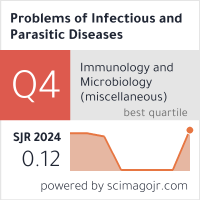STUDY ON TICKS REMOVED FROM PATIENTS FOR INFECTION WITH BORRELIA BURGDORFERI AND THEIR NUMBER DEPENDING ON TEMPERATURE AND PRECIPITATION IN 2016-2021
DOI:
https://doi.org/10.58395/pipd.v50i1.82Keywords:
B. burgdorferi, ticks, temperature, precipitationAbstract
Background: Deacarization, applied epidemiological measures, and climatic factors affect the abundance of ticks. On the other hand, ticks themselves are a factor of great epidemiological and epizootic importance. Studies concerning the influence of climatic factors on ticks and their infection with B. burgdorferi are still limited in Bulgaria. The aim was to investigate the abundance of ticks in relation to temperature and precipitation, as well as the infection with B. burgdorferi of ticks removed from patients during the period 2016-2021.
Materials/methods: A total of 10,907 ticks were collected from patients and classified according to species and stage of development. Nested PCR was performed targeting two sites of the spacer region between 5S and 23S of B. burgdorferi sensu lato rRNA. Weather data were collected from free Internet meteorological sites.
Results: It was found that 92-96% of the ticks belonged to the species Ixodes ricinus. PCR data were obtained for infestation of ticks in 2016-2021. Only in 2018, the highest number of ticks was observed in May, while in the other five years - in June, which was analyzed in relation to the average temperature and precipitation.
Conclusion: An increase in tick abundance was observed at average temperatures around 20°C, with rainfall on the days before the peak. During the 6-year period, the highest number of ticks was collected in June 2021, which could be explained with the high average temperatures and abundant precipitations during the preceeding spring months (April – June).
Downloads
References
Mead PS, Epidemiology of Lyme disease, Infect Dis Clin North Am, 2015 Jun; 29(2):187-210.
Semenza JC and Suk JE, Vector-borne diseases and climate change: a European perspective. FEMS Microbiol Lett. 2018 Jan; 365(2): fnx244.
Randolph SE, Rogers DJ. The arrival, establishment and spread of exotic diseases: patterns and predictions. Nat Rev Microbiol 2010; 8:361–71.
Semenza JC, Menne B. Climate change and infectious diseases in Europe. Lancet Infect Dis 2009; 9:365–75.
Lindgren E, Andersson Y, Suk JE et al. Monitoring EU emerging infectious disease risk due to climate change. Science 2012; 336:418–9.
Jaenson TGT, Jaenson DGE, Eisen L et al. Changes in the geographical distribution and abundance of the tick Ixodes ricinus during the past 30 years in Sweden. Parasit Vectors 2012; 5:8.
Daniel M, Danielova V, Kriz B et al. Shift of the tick Ixodes ricinus and tick-borne encephalitis to higher altitudes in central Europe. Eur J Clin Microbiol Infect Dis 2003; 22:327–8.
Heinz FX, Stiasny K, Holzmann H et al. Emergence of tick-borne encephalitis in new endemic areas in Austria: 42 years of surveillance. Euro Surveill 2015; 20:9–16.
Померанцев БИ, Паукообразные, Иксодовые клещи (Ixodidae), Издателство Академии Наук СССР, Москва, 1950, Ленинград, том ІV, вып. 2.
Rijpkema SG, Molkenboer MJ, Schouls LM, Jongejan F, Schellekens JF. Simultaneous detection and genotyping of three genomic groups of Borrelia burgdorferi sensu lato in Dutch Ixodes ricinus ticks by characterization of the amplified intergenic spacer region between 5S and 23S rRNA genes. J Clin Microbiol. 1995 Dec;33(12):3091-5.
freemeteo.bg, Времето. Прогнози за времето. Времето сега. Предупреждения за сурово време.
meteoblue.com, Времето София.
Analyses of acute infectious diseases in Bulgaria 2016-2020 (In Bulgarian), NCIPD, Department of Epidemiology, https://www.ncipd.org
Estrada Peña A, Cutler S, Potkonjak A, Vassier Tussaut M, Van Bortel W, Zeller H, Fernández Ruiz N, Mihalca AD. An updated meta analysis of the distribution and prevalence of Borrelia burgdorferi s.l. in ticks in Europe. Int J Health Geogr (2018); 17:41.
Гладнишка ТК, Микробиологични проучвания върху вектори и резервоари на някои предавани с кърлежи бактериални инфекции при хората, Дисертационен труд за ОНС „Доктор”, научни ръководители И. Христова, Т. Кантарджиев, София, 2008.
Downloads
Published
Issue
Section
License
Copyright (c) 2022 Teodora Gladnishka, Iva Christova, Iva Trifonova, Vladislava Ivanova, Elitsa Panayotova, Evgenia Taseva (Author)

This work is licensed under a Creative Commons Attribution 4.0 International License.






